


A newsletter for modern marketers.

TRUSTED BY THE WORLD'S SMARTEST MARKETERS
Free ad performance benchmarks every week.

Live webinars and strategy sessions with industry leaders.
Watch all previous episodes on our YouTube channel.
Insider strategies from the smartest brands in ecommerce.
SEE LATEST POSTS:

Channel Strategy: How to Choose the Right Marketing Channels for Your Business

In an era where marketers juggle a dozen platforms before breakfast, choosing the right marketing channels has never mattered more.
The best marketing channel strategy isn’t about chasing trends, it’s about connecting with your audience efficiently, maximizing ROI, and aligning every campaign with a clear purpose.
Without a structured approach, channels overlap, results blur, and performance stalls. The key is to be selective, strategic, and data-driven, building a channel mix that supports growth.
This article walks you through how to choose the right marketing channels by defining your audience, evaluating each option by ROI and scalability, and using data to prioritize what works.
You’ll learn how to audit your current mix, test new channels effectively, and avoid common pitfalls like overlap, saturation, and attribution distortion so your marketing strategy becomes more focused, efficient, and impactful.
The Problem: Why Channel Strategy Often Fails
Many teams still treat marketing channels like a buffet: piling on whatever looks appealing without considering how it all fits together.
Budgets get scattered across platforms, results flatten, and leaders are left wondering which effort actually moved the needle.
When channels overlap, costs rise and attribution gets fuzzy. One campaign cannibalizes another, and performance metrics stop telling a coherent story. The result isn’t a growth engine; it’s noise.
A solid marketing channel strategy brings order to that chaos. It aligns every touchpoint with clear objectives (awareness, acquisition, retention) and ensures each dollar supports a measurable outcome rather than a hunch.
87% of marketing leaders report experiencing campaign performance issues, with poor channel fragmentation and other channel strategy issues being the primary driver.
In other words: it’s not about being everywhere. It’s about being strategic about where and why you show up.
Core Decision Criteria for Channel Selection
A disciplined channel strategy starts with clear evaluation criteria. Each potential channel should be measured against consistent axes, not just gut instinct or trends.
The goal is to understand where your audience actually engages, what outcomes the channel supports, and whether it’s sustainable to scale.
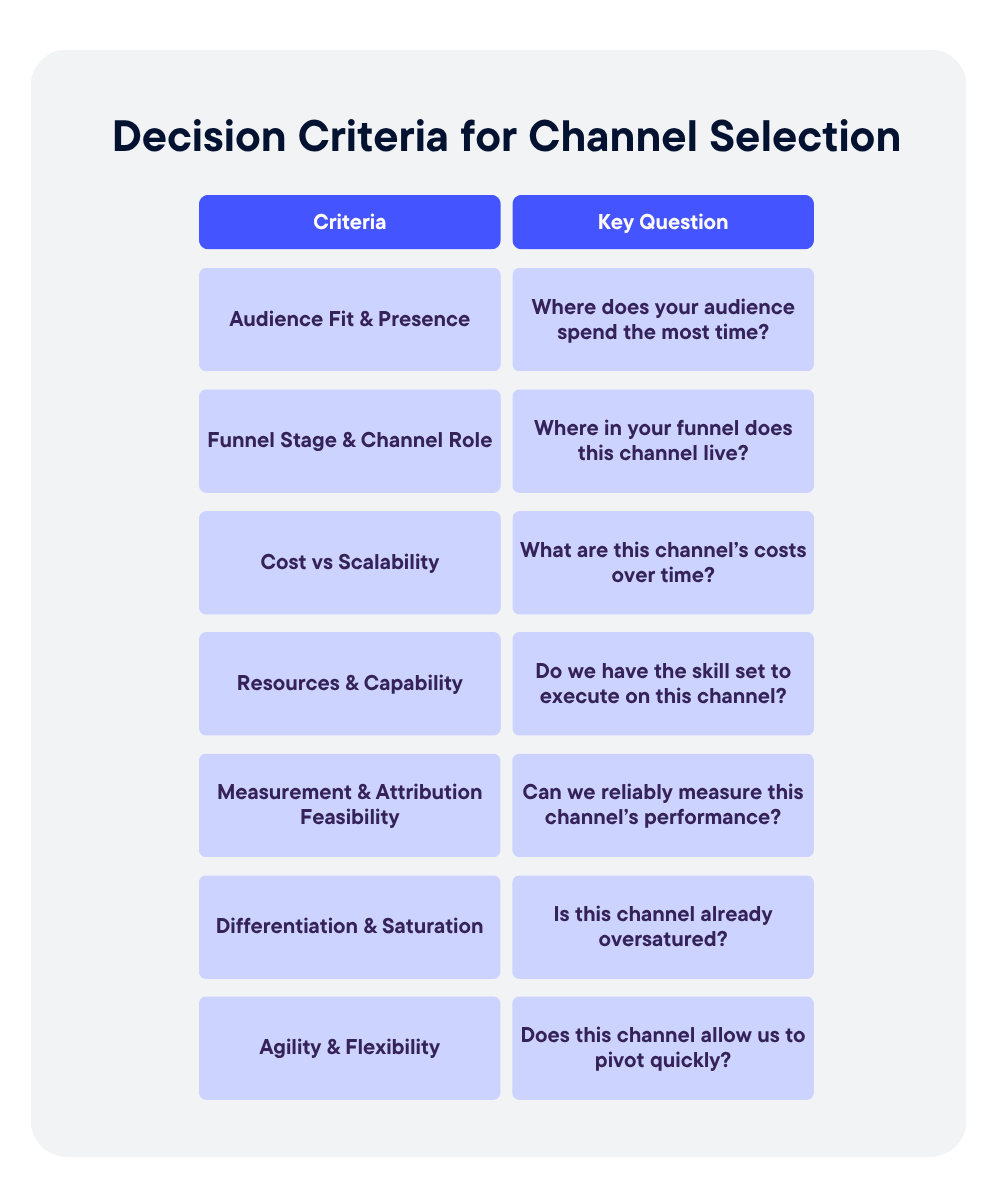
Audience Fit & Presence
The best-performing channels are the ones your audience already lives in.
Before investing, confirm where your target customers spend time and what content formats they respond to: short-form video, newsletters, long-form education, etc.
Funnel Stage & Channel Role
Every channel should serve a defined purpose: building awareness, driving acquisition, or nurturing retention.
Mapping this alignment ensures you’re not running top-of-funnel tactics where conversion is the goal, or vice versa.
Cost vs. Scalability
Evaluate each channel’s economics over time. Some channels deliver strong ROI early but taper off as competition rises or bids inflate.
Assess both upfront costs (setup, creative, tech) and marginal costs (CPC, CPM) to gauge long-term scalability without diminishing returns.
Resources & Capability
Even high-potential channels fail without proper execution. Do you have the in-house skill sets (copywriting, design, ad operations, data analysis) to manage the channel effectively?
If not, factor in outsourcing costs or training time before committing.
Measurement & Attribution Feasibility
If a channel can’t be reliably measured, it can’t be optimized.
Make sure you know how to choose marketing channels that integrate smoothly into your analytics and attribution models, so you can connect spend to results and continuously refine performance.
Differentiation & Saturation
Overcrowded platforms drive higher costs and lower impact. Look for channels where your competitors are not dominant; emerging or underutilized spaces often yield better ROI and creative opportunities.
Agility & Flexibility
Markets shift fast. Channels that allow you to pivot quickly (test creative variations, adjust bids, or redeploy spend) offer resilience in volatile conditions.
Agility often beats perfection in modern marketing.
Channel Types & Their Roles
Before mapping specific channels to your strategy, it helps to understand the broader framework they fall into.

Keen Decision Systems divides marketing channels into four major categories, each with different strengths and tradeoffs:
- Paid channels offer speed and scalability but require constant optimization as costs rise.
- Organic channels build equity over time but demand patience and consistent effort.
- Digital channels provide agility, targeting, and real-time feedback.
- Traditional channels like print, radio, and direct mail reach broad audiences but are harder to measure precisely.
These dimensions highlight key tradeoffs: speed versus sustainability, reach versus control, experimentation versus consistency.
The most effective strategies blend these forces rather than relying too heavily on one.
Once you’ve defined your evaluation criteria, the next step is mapping them to the major channel types within this framework.
Owned/Organic (Blog, Social Media, SEO)
Owned channels are the long game. They require time and consistency but build durable brand equity and compound over months or years.
Blogs, social media profiles, and SEO-optimized content give you full creative control and low incremental cost once established.
They’re ideal for awareness and education but demand patience before measurable ROI appears.
Paid/Performance (PPC, Ads, Sponsored Content)
Paid channels deliver speed and precision. They’re easy to test, quick to scale, and provide fast feedback loops, which is perfect for validating new offers or audiences.
The tradeoff: rising competition and cost volatility. As performance channels saturate, ROI can erode without constant optimization.
Earned/Shared/Partner (PR, Influencer, Content Syndication)
Earned exposure adds credibility and reach you can’t buy directly. Whether through PR mentions, influencer collaborations, or partner syndication, these channels extend your visibility to new audiences and reinforce trust.
However, they’re less predictable and harder to measure, which means they work best alongside more controllable tactics.
Direct/Relationship Channels (Email, In-App, Push)
Direct channels nurture retention and loyalty. They allow you to communicate with customers without intermediaries or algorithms, giving full control over timing and message.
Direct channels also present high potential for personalization, especially when integrated with CRM data.
Hybrid/Emerging Channels (Affiliate, Podcast, Events)
These channels blur the lines between organic and paid. They’re often niche, with lower competition and high creative potential, but require experimentation to find traction.
Podcasts, affiliate programs, and live events can build deep audience engagement if aligned with your brand voice and goals.
Keen’s framework divides channels into paid, organic, digital, and traditional categories to emphasize their different tradeoffs: speed versus sustainability, reach versus control, experimentation versus consistency.
The most effective strategies blend these dimensions rather than relying too heavily on one.
Framework for Building Your Channel Strategy
A channel strategy isn’t a one-time plan, it’s an iterative system for testing, learning, and scaling what works.
The process moves from exploration to execution through a disciplined set of steps that keep decisions data-driven and aligned with business goals.
Audit Existing Channel Performance
Start by taking inventory. Gather data on each active channel’s cost, reach, conversion rate, and incremental value, not just vanity metrics.
Look for overlap between channels (e.g., paid social clicks converting customers already reached via email) and identify attribution blind spots.
This snapshot becomes your baseline for smarter investment.
Hypothesis Scoring & Ranking
Treat each potential channel as an experiment. Score it against your decision criteria, including audience fit, ROI potential, risk level, and resource requirements.
The goal isn’t to predict the future perfectly but to rank channels by the strength of their hypotheses. This keeps you focused on the opportunities with the highest strategic upside.
Pilot & Test Approach
Before you commit to a given budget, validate your assumptions through small-scale pilots.
Keen’s research emphasizes testing early and often: running controlled experiments to see how each channel performs in practice.
Use clear KPIs like cost per lead, engagement rate, or conversion lift to decide what deserves more spend.
Role Definition & Funnel Mapping
Once you’ve identified the most promising channels, assign them clear roles in your funnel. Which ones drive awareness? Which nurture conversion or retention?
Mapping these interactions helps prevent duplication and ensures every channel feeds into the next stage of your customer journey.
Attribution & Feedback Loops
Decide how success will be measured. Whether you use last-click, multi-touch, or marketing mix modeling (MMM), attribution should provide actionable insight rather than inflated numbers.
More advanced teams are turning to Bayesian models for a nuanced view of multi-channel influence. Build dashboards that update automatically so performance data continuously informs allocation.
Scale, Reallocate, and Iterate
Once your tests identify clear winners, double down on what’s working and pause what’s not. Revisit your mix quarterly to adjust for seasonality, cost shifts, or audience fatigue.
Instead, it’s more effective to focus your spend in powerful bursts or waves, pushing one channel hard while pulling back on others, then rotating effort as performance saturates.
This dynamic approach maximizes impact while minimizing waste, preventing you from spreading budget thinly across too many platforms at once.
Source: Eshghi et al., “Optimal Resource Allocation in Influence Networks,” arXiv:1702.03432.
A strong channel strategy is alive, not static. It grows with your business, your data, and your audience, compounding insight and ROI over time.
Tradeoffs, Risks, & Channel Pitfalls
Even a well-planned channel strategy can stumble if the moving parts aren’t managed carefully. Most failures don’t come from bad ideas, they come from invisible tradeoffs, misaligned timing, or operational friction.
Understanding these pitfalls upfront can help you prevent costly detours.
Overlap & Cannibalization
Not every channel expands your reach. Sometimes two or more hit the same audience, doubling your spend without adding new prospects.
Overlapping audiences between, say, paid social and remarketing can drive up costs and muddy attribution.
Use audience exclusions and cohort analysis to ensure your channels complement, not compete.
Attribution Distortion
When success metrics give too much credit to one channel (for instance, last-click conversions inflating search ROI) teams can make the wrong optimization calls.
Attribution distortion leads to overinvestment in easy-to-measure channels while undervaluing long-term drivers like content or PR. Cross-channel models and data triangulation help correct the imbalance.
Saturation & Diminishing Returns
Paid channels are efficient until they’re not. As spend increases, competition drives up bids and ROI erodes.
Recognizing this curve early lets you shift from high-cost acquisition to nurturing and retention before performance flattens.
Resource Dilution
More channels don’t always mean more results. Spreading teams thin leads to sloppy execution, slow response times, and half-baked creative.
A lean, well-managed mix consistently outperforms an overloaded one. Focus on mastery, not mere presence.
Dependence on External Platforms
Platforms change faster than you can plan. Algorithm updates, privacy policies, or ad pricing shifts can instantly rewrite your playbook.
Balance external reliance with owned channels like email or SEO that you fully control.
Ramp Time Mismatch
Every channel operates on its own timeline. SEO and content marketing may take six months to mature, while paid ads can drive traffic in days.
Mismanaging these timelines (for example, expecting organic to deliver at launch) can create gaps in visibility or pressure on paid spend.
Fragmented Messaging & Silos
When different teams own different channels without coordination, brand voice fractures. Messaging feels inconsistent and customer experiences become disjointed.
Align strategy, creative, and reporting across departments to maintain one cohesive narrative.
A strong channel mix is as much about orchestration as selecting marketing channels. Avoiding these pitfalls ensures your efforts add up to momentum, not noise.
3 Examples For How to Choose the Right Marketing Channels
The best way to understand channel strategy is to see it in action.
Below are three simplified examples that show how different types of businesses apply the same process: hypothesis, test, learn, and adjust.
Example #1: SaaS Startup
A B2B software startup wanted to attract qualified leads for its free trial program.
The team hypothesized that LinkedIn Ads + content download + email nurture would yield the best conversion flow given their professional audience.
After a two-month pilot, they tracked cost per lead (CPL), engagement with gated content, and downstream trial activation.
LinkedIn drove high-quality leads but at a steep cost. However, email nurtures converted 22% of those trial users: a strong retention signal.
The team reallocated part of their ad budget toward organic LinkedIn content and lifecycle emails, improving total ROI by 35%.
Key takeaway: Start broad with paid reach, then shift investment toward owned or direct channels that sustain engagement.
Example #2: DTC Brand
A direct-to-consumer beauty brand launched a new product line and wanted to find which mix of channels would generate both awareness and repeat purchases.
They ran an influencer + paid social + retargeting campaign for six weeks.
Initial metrics showed strong engagement but weak conversion from Instagram ads. Retargeting audiences were small and expensive. By surveying new customers, they learned that many discovered the brand through influencer posts but converted later via email or SMS.
The team reduced social ad spend, doubled down on SMS and push notifications, and built a referral program.
Within one quarter, repeat purchase rate rose by 28% and CAC dropped by 18%.
Key takeaway: Attribution often hides the “real” driver; follow the customer journey beyond the first click.
Example #3: Local Business
A neighborhood fitness studio wanted to rebuild attendance after a renovation, but they’re not sure about the best marketing channels for small businesses.
Rather than rely solely on digital, they paired offline outreach (local events, direct mail) with digital discovery (paid search, local social ads).
Their hypothesis: combining personal community touchpoints with online visibility would amplify trust and bookings. Test metrics included event attendance, coupon redemption, and new membership signups.
The hybrid approach worked: local events converted 1 in 4 attendees, while social ads boosted awareness at minimal cost.
They sustained the model by running one event per quarter, supported by targeted Google Ads and a referral discount.
Key takeaway: Offline and online channels can reinforce each other, especially when community and credibility matter.
Across all three cases, the lesson is the same: an effective channel strategy framework in 2025 is based on data-informed experimentation.
Test assumptions, measure real outcomes, and adjust the mix based on evidence.
Channel Selection Checklist
A great channel strategy doesn’t just live in a slide deck, it’s something you can operationalize and refine over time.
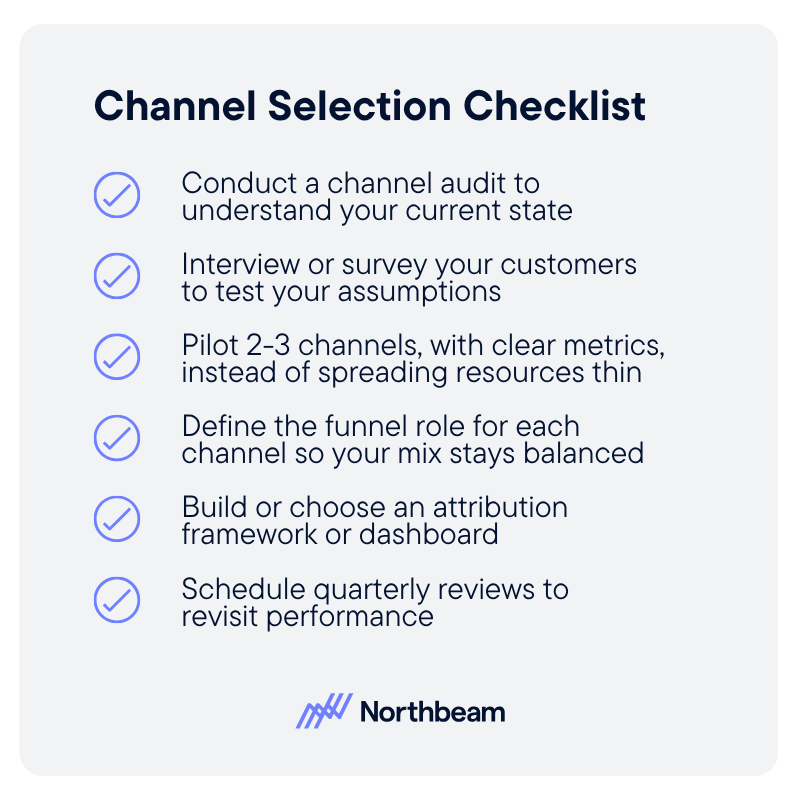
Use this checklist to turn your evaluation into an actionable plan that keeps your marketing mix sharp and accountable:
- Conduct a Channel Audit: Start with what’s already running. Review each channel’s spend, reach, and performance metrics to identify overlap, underperformance, and opportunities to consolidate.
- Interview or Survey Your Customers: Go straight to the source. Ask your audience where they actually spend time and what types of content influence them most. Even a small sample of customer feedback can reveal blind spots in your assumptions.
- Pilot 2-3 New Channels (with Clear Metrics): Instead of spreading thin, choose a few new channels to test deliberately. Define success metrics upfront (cost per lead, engagement rate, retention lift) and evaluate after a fixed test window.
- Define the Funnel Role for Each Channel: Every channel should have a specific job to do. Label it clearly (awareness, acquisition, retention) so your mix stays balanced and your performance data stays interpretable.
- Build or Choose an Attribution Framework/Dashboard: Select a measurement model (last-click, multi-touch, or MMM) that fits your scale and tech stack. Visualize data in a dashboard that lets you see trends, compare channels, and reallocate fast.
- Schedule Quarterly Reviews: Set a recurring cadence to revisit channel performance. Markets, audiences, and costs shift, and your mix should, too. Re-run prioritization each quarter to cut what’s stale and double down on what’s scaling.
A disciplined checklist like this keeps your marketing channels from running on autopilot. Strategy isn’t about doing more; it’s about doing the right things consistently.
Build Smarter, Not Broader
A strong channel strategy isn’t about being everywhere at once. It’s about showing up where it counts with intention, focus, and measurable impact.
Start by auditing what’s working. Then test a few new channels with purpose, and use data to guide every adjustment.
Over time, the result isn’t just better ROI, it’s a marketing engine that compounds insight, efficiency, and trust.
Don’t wait for perfect information. Pick two actions from the checklist above and start this week.

Ad Fatigue in Digital Marketing: How to Recognize & Remedy It

If your ads used to crush performance but now barely get clicks, it’s probably not the algorithm’s fault: it’s ad fatigue.
Even the best creative gets old fast when audiences see it over and over again. Engagement drops, costs rise, and before you know it, you’re spending more to achieve less.
Ad fatigue happens when your audience becomes so familiar with a campaign that they stop noticing it altogether.
The result? Declining CTR, rising CPC, and wasted media spend.
Here’s what you’ll learn in this guide:
- How to recognize ad fatigue: the key signals and metrics that reveal when performance is slipping
- Why it happens: the most common creative, targeting, and algorithmic culprits
- How to fix it fast: proven remedies and prevention tactics to keep campaigns performing longer
In short, this article helps marketers recognize, diagnose, and fix ad fatigue before it drains ROI. You’ll walk away with a clear playbook to keep your creative fresh, your audience engaged, and your campaigns cost-efficient.
What Is Ad Fatigue?
Ad fatigue (sometimes called creative fatigue or ad wear-out) happens when audiences are exposed to the same creative too often.
Over time, what was once engaging starts to feel repetitive or irrelevant, and viewers begin to scroll past, ignore, or even react negatively to your ads.
It’s important to distinguish ad fatigue from general underperformance. A campaign might underperform for reasons like poor targeting, weak messaging, or seasonality, but ad fatigue specifically refers to performance decline over time as a result of overexposure.
In other words, it’s not that your ad never worked. It just stopped working once people had seen it too many times.
This phenomenon can occur across nearly every digital channel: social media feeds, display networks, video platforms, and even retargeting campaigns.
The more often a user sees the same creative in these spaces, the less likely they are to engage with it, and the faster your results begin to drop.
Why Ad Fatigue Matters
Ad fatigue isn’t just a creative nuisance. It has real business consequences: your engagement drops, costs climb, efficiencies erode, and brand perception can take a hit.
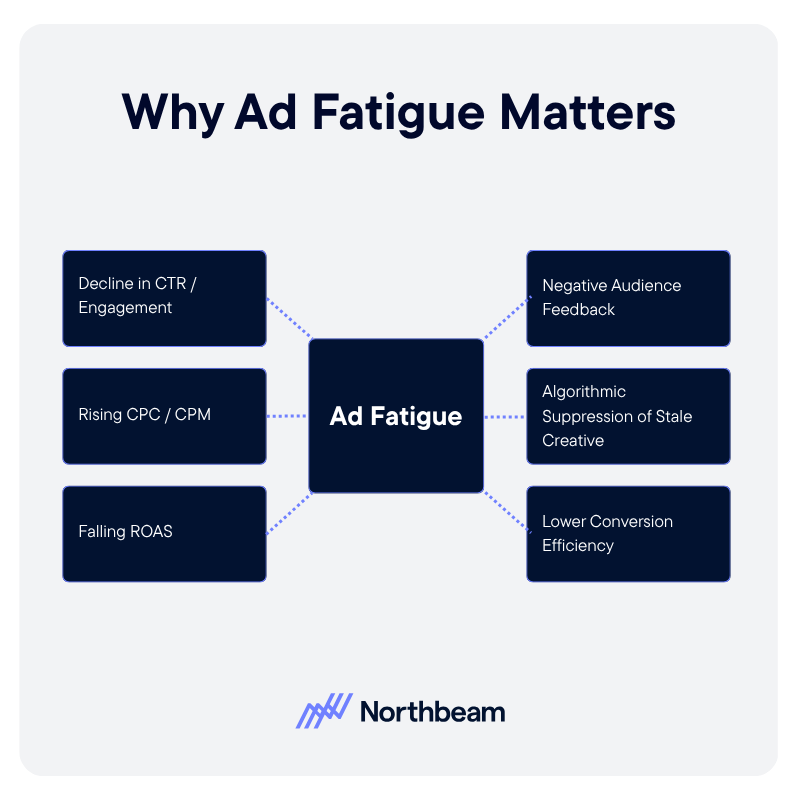
Key risks include:
Decline in CTR / Engagement
When an audience sees the same ad too often, they stop clicking, reacting, or paying attention.
For example, a study by Meta Platforms found that after just four repetitions of the exact same creative, the likelihood of a click dropped by about 45%.
Rising CPC / CPM
When engagement falls, the advertising platforms’ algorithms recognize your creative as less relevant and inefficient, so the cost to reach or get action from users goes up.
Falling ROAS / Conversion Efficiency
With fewer clicks and higher costs, the return on your ad spend drops. Essentially, you spend more to get less.
Negative Audience Feedback
Repetition can annoy or alienate users. Comments like “I’ve seen this already”, ad hides, or users choosing “not interested” all signal damage. That in turn can harm how users feel about your brand.
Algorithmic Suppression of Stale Creative
Digging deeper, when your creative becomes stale (low engagement, negative feedback, high frequency), ad platforms will serve it less or bid it up in cost, reducing reach and efficiency further.
It’s tempting to think “we’ll refresh eventually,” but the data shows that damage accumulates fast.
The higher you let costs rise and engagement fall, the harder (and more expensive) it’ll be to recover from the slide.
In short: ignoring creative fatigue puts your campaign health, budget efficiency and brand standing at risk.
Recognizing Ad Fatigue (Signals & Metrics)
Ad fatigue doesn’t always announce itself loudly. It can creep in gradually through subtle performance shifts.
To catch it early, marketers should monitor both quantitative and qualitative signals that reveal when an audience has seen too much of the same creative.
Quantitative Indicators
- Consistent drop in CTR or engagement rate: A steady decline in click-throughs or interactions is one of the clearest signs your audience is tuning out.
- Rising CPC or CPM with a stable budget: When your costs climb but impressions or clicks don’t, platforms may be penalizing your ad for poor relevance or repetitive delivery.
- Falling conversion rates or ROAS despite stable traffic: If your traffic remains steady but sales, sign-ups, or return on ad spend drop, fatigue may be eroding effectiveness.
- High ad frequency: Seeing the same ad too many times leads to boredom and frustration. As a general rule, frequency above 3-4 impressions per user often signals it’s time to refresh.
- Plateauing reach: When you’re no longer expanding to new audiences, it can indicate saturation within your target segment.
Qualitative Indicators
- Negative audience feedback: Comments like “I’ve seen this ad too much” or increased use of “Hide this ad” options suggest irritation and declining sentiment.
- Internal performance reviews: Feedback from creative, media, or account teams noting repeated visuals or stale messaging often correlates with performance dips.
- Audience sentiment monitoring: Social listening tools or manual reviews can reveal when tone shifts from neutral to negative, an early warning that perception is slipping.
Together, these metrics and insights create an early detection system.
By watching for even small shifts in engagement or sentiment, teams can refresh creatives before fatigue causes serious performance loss.
Root Causes & Risk Factors of Ad Fatigue
Understanding the root causes of ad and creative fatigue helps prevent the problem before it drains your budget.
Overuse Of The Same Creative
Running a single ad or a limited set of variations for too long is the most common driver of fatigue. Even high-performing creative will eventually lose impact once it’s seen too many times.
Narrow Or Saturated Targeting
When your audience pool is too small, the same users are repeatedly served your ads, especially if you’re also retargeting them across platforms.
Expanding or rotating segments can help distribute impressions more evenly.
Infrequent Creative Refresh Cycles
Without a consistent refresh schedule for visuals, copy, or calls-to-action, fatigue is inevitable.
Regularly rotating creative assets keeps campaigns feeling fresh and prevents diminishing returns.
Rigid Frequency Settings Without Caps
Overly aggressive bidding or missing frequency limits can lead to excessive impressions per user.
Implementing caps ensures users see your message enough to remember it, but not enough to get tired of it.
Cross-Channel Overlap
Delivering identical or similar creatives across multiple channels (e.g., Meta, YouTube, Google Display) can overwhelm the same audience.
Differentiating creative formats or sequencing them across channels helps prevent oversaturation.
Algorithmic Downranking
Ad platforms deprioritize creatives that get low engagement or negative feedback. Once this happens, reach declines and costs rise, creating a cycle of underperformance that’s hard to recover from.
Weak Creative Strategy Or Lack Of Testing
Without structured experimentation (like A/B testing, message rotation, or creative benchmarking) teams miss the early warning signs that an ad is wearing out.
A strong creative testing framework ensures you catch fatigue before performance drops.
How to Overcome Ad Fatigue: Remedies & Prevention Strategies
Once you’ve identified signs of fatigue, the next step is to act fast.
The key to preventing ad performance decline is proactive management: regularly refreshing creatives, rotating audiences, and automating monitoring to catch early dips before they hurt ROI.
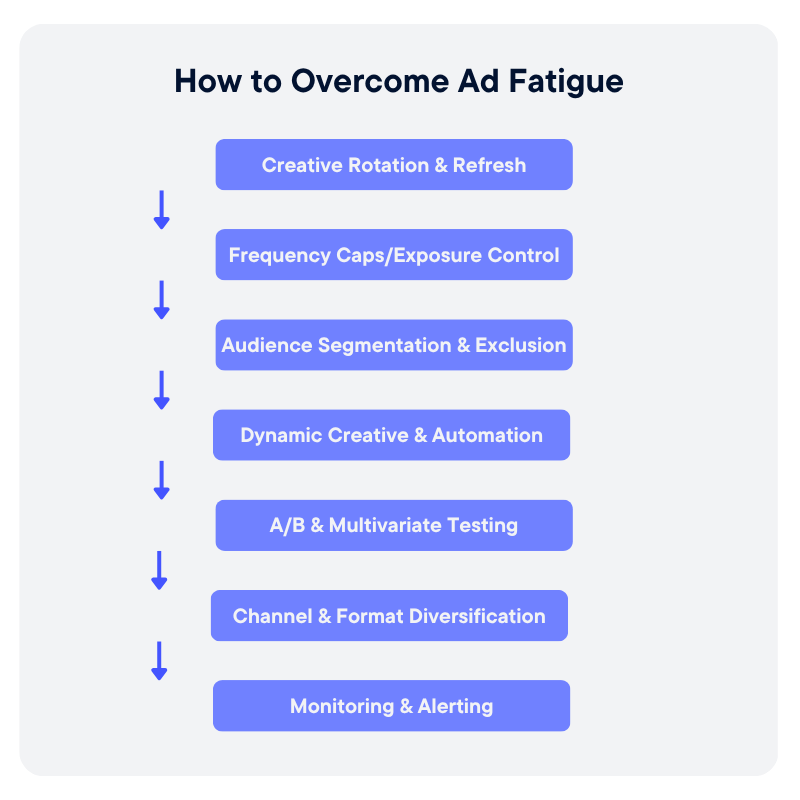
Here are seven steps to prevent ad campaign fatigue across Facebook (Meta), Google, and other channels.
Creative Rotation & Refresh
- Maintain multiple creative variants and refresh visuals, headlines, and CTAs on a regular schedule (every few weeks for always-on campaigns).
- Use seasonal hooks, trending topics, or new product angles to keep messaging timely and relevant.
- Experiment with alternate formats, such as short-form video, carousel, or interactive ads, to re-engage users who have grown tired of static visuals.
Frequency Capping / Exposure Control
- Set limits on how many times an individual user sees your ad within a set period (e.g., 3–5 impressions per week).
- Use platform-level frequency caps or automated rules to manage exposure across campaigns
- Pause or rotate creatives once thresholds are reached to prevent overexposure and preserve brand sentiment.
Audience Segmentation & Exclusion
- Break audiences into smaller, more precise segments and tailor creatives to each group’s interests or behaviors.
- Exclude users who have already converted or have seen your ad multiple times
- Gradually expand reach with lookalike or similar audiences to discover new engagement pockets.
Dynamic Creative & Automation
- Use Dynamic Creative Optimization (DCO) tools to automatically mix and match creative elements for optimal performance.
- Apply automation rules to pause or refresh underperforming creatives based on metrics like CTR, frequency, or cost per conversion.
- Let algorithms handle routine adjustments while your team focuses on strategy and creative innovation.
A/B & Multivariate Testing
- Continuously test variations of visuals, headlines, copy, and formats to understand what resonates.
- Retire versions as soon as engagement starts to drop, before fatigue fully sets in.
- Maintain a structured testing cadence to ensure ongoing learning and optimization.
Channel & Format Diversification
- Spread exposure across multiple platforms (social, display, video, search) to prevent oversaturation of any single audience.
- Sequence creative delivery (e.g., teaser video -> carousel -> static reminder ad) to maintain interest and storytelling momentum.
- Adjust creative formats by channel to make each placement feel fresh and contextual.
Monitoring & Alerting
- Build dashboards that track CTR, CPC, frequency, conversions, and audience sentiment over time.
- Set up automated alerts for sudden drops in engagement or unexpected cost spikes.
- Consider advanced detection techniques (e.g., change-point or anomaly analysis) to catch early fatigue in large-scale campaigns.
Ad Fatigue Case Study
Even the best-performing campaigns eventually hit a wall.
The key difference between teams that sustain success and those that burn through budget is how quickly they recognize and respond to fatigue.
Problem
A direct-to-consumer skincare brand noticed engagement on its Meta ads drop by nearly 30% over two weeks.
Click-through rates were falling, CPMs were creeping up, and customer comments increasingly mentioned seeing “the same ad again.”
The team realized that while their creative had once been a top performer, it hadn’t been updated in nearly two months, and the same video was running across Meta, YouTube, and Google Display.
Solution
The marketing team conducted a quick diagnostic: they compared audience frequency data, analyzed feedback sentiment, and confirmed fatigue as the culprit.
Within a week, they rolled out refreshed creatives featuring new visuals, reworded CTAs, and UGC-style testimonials.
They also implemented frequency caps and expanded to a broader lookalike audience to dilute overexposure.
Impact
CTR rebounded by 22% within ten days, CPMs fell back to their pre-fatigue baseline, and positive engagement returned.
More importantly, the team built an automated refresh schedule and dashboard alerts to detect similar dips in the future, turning a reactive fix into an ongoing preventive system.
This simple cycle of detect, refresh, and automate demonstrates how even small adjustments can revive fatigued campaigns and protect long-term ad performance.
Ad Fatigue Best Practices Checklist
To keep creative fatigue from eroding performance, build these principles into your campaign workflow from day one.
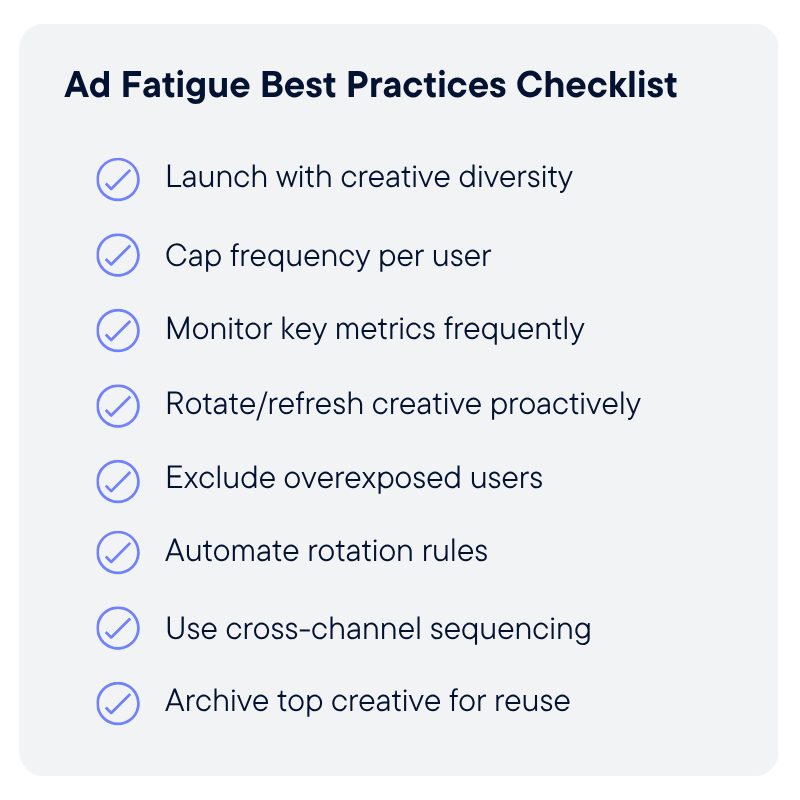
Launch With Creative Diversity
Start every campaign with multiple visuals, headlines, and CTAs to reduce early repetition and provide a strong foundation for testing and optimization.
Cap Frequency Per User
Limit how often each user sees your ad to avoid overexposure and irritation. This helps maintain engagement and keeps brand sentiment positive.
Monitor Key Metrics Frequently
Track CTR, CPC, CPM, ROAS, and frequency together. Sudden shifts or cost spikes often signal the first signs of ad fatigue in campaigns.
Rotate Or Refresh Creative Proactively
Don’t wait for performance to collapse. Schedule creative updates based on engagement trends, campaign length, or key seasonality shifts.
Exclude Overexposed Users
Use audience exclusions to remove people who’ve already converted or seen your ad too many times. This helps reset your exposure balance and keeps targeting efficient.
Automate Rotation Rules
Apply automated triggers or platform rules to pause stale creatives and prioritize high-performing variants. Automation keeps campaigns agile without constant manual oversight.
Use Cross-Channel Sequencing
Guide users through a story across channels. For example, build awareness with video, drive engagement on socials, and convert through display retargeting.
Archive Top Creatives For Reuse (With Variation)
Keep a library of proven creatives to repurpose later with refreshed visuals or copy. This saves production time while maintaining the proven performance of earlier assets.
Keep Your Campaigns Fresh & Your ROI Strong
Ad campaign fatigue doesn’t always look dramatic. It creeps in slowly, quietly draining performance and budget.
But with early detection and consistent creative refreshes, you can turn it from a hidden liability into an opportunity for smarter, more adaptive marketing.
Start by auditing your current campaigns. Look for early warning signs like declining engagement, rising costs, or growing audience frequency.
Then, act fast: implement at least two remedial tactics this week, whether it’s refreshing your creative, capping frequency, or testing a new audience segment.
For long-term resilience, build a fatigue-monitoring system. Use dashboards and automated alerts to catch drops early, schedule regular creative rotations, and make ad reviews a standing part of your campaign process.
Your best campaigns don’t have to fade quietly. Intervene early, stay creative, and keep testing. Freshness isn’t just about new ideas, it’s about maintaining momentum.

Churn Analysis: Identifying Why Customers Leave (And How to Win Them Back)

Customer churn is one of the clearest signals that something in your customer experience, product, or pricing isn’t working as it should.
But it’s also one of the most valuable sources of insight if you know how to analyze it.
Churn analysis is the systematic process of studying why customers leave, when it happens, and what patterns predict it.
By combining quantitative data (like engagement metrics and revenue loss) with qualitative feedback (like exit surveys and interviews), teams can uncover the real reasons behind attrition and act before it compounds.
In this guide, we’ll break down how to:
- Define and measure churn effectively
- Recognize the leading signals that predict customer loss
- Identify common root causes and risk factors
- Apply practical recovery and win-back strategies
- Use the right tools and models to make churn analysis scalable
The goal is to help product, growth, and marketing teams turn churn from a passive KPI into a powerful customer retention strategy that strengthens loyalty, boosts lifetime value, and drives sustainable growth.
What Is Churn Analysis?
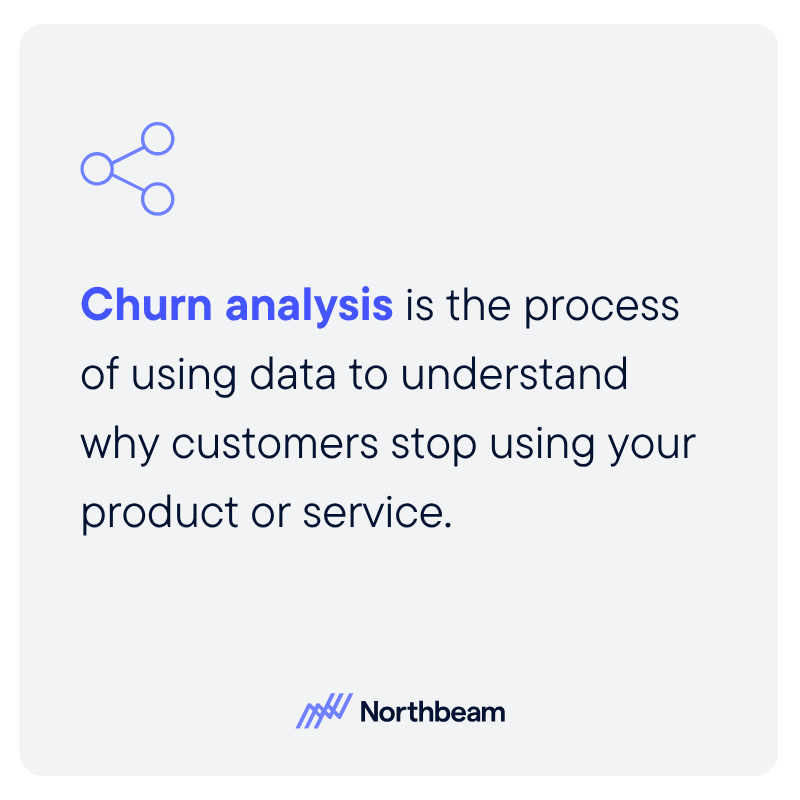
Churn analysis is the process of using data to understand why customers stop using your product or service.
It goes beyond simply tracking who leaves. It's about uncovering the behavioral, experiential, and contextual factors that drive those decisions.
Churn analysis helps businesses identify churn patterns so they can act before it’s too late. By examining customer activity, engagement, sentiment, and lifecycle data, teams can detect early warning signs, diagnose the root causes, and implement interventions that reduce churn and increase retention.
Churn-Related Definitions
There are a few related concepts worth clarifying before we dive in:
Churn Rate vs. Retention Rate
Churn rate measures the percentage of customers who leave during a given period, while retention rate measures the opposite: those who stay.
Together, they give a full picture of customer loyalty and stability.
Voluntary vs. Involuntary Churn
Voluntary churn happens when customers intentionally cancel or stop using a product, often due to dissatisfaction or a better alternative.
Involuntary churn results from payment failures, expired cards, or account issues; situations where the customer didn’t necessarily choose to leave.
Customer Churn vs. Revenue Churn
Customer churn tracks the number of customers lost, whereas revenue churn measures the dollar value lost from those customers.
A business might lose fewer customers overall but still face high revenue churn if those who leave are high-value accounts.
In practice, effective churn analysis blends all these perspectives to reveal what’s really driving attrition and where the biggest opportunities for improvement lie.
Why Churn Analysis Matters
Customer churn is a direct hit to a company’s growth engine. Every customer who leaves takes their recurring revenue, advocacy, and future upsell potential with them.
Churn analysis is critical so you can:
Check Lost Revenue and Slower Growth
When churn goes unchecked, acquisition efforts simply fill a leaking bucket.
A high churn rate can offset even the strongest acquisition performance, forcing teams to spend more just to maintain the same topline.
Stop Erosion of Customer Lifetime Value (CLV)
CLV depends on how long customers stay and how much they spend over time.
Even modest improvements in customer retention can have an outsized effect; research by Bain & Company shows that even a 5% increase in retention can lift profits by 25–95%.
Glean Product and Service Insights
Churn data is a mirror reflecting where your product, experience, or messaging falls short.
By analyzing churn reasons and feedback trends, teams can uncover specific issues, from confusing onboarding flows to missing features or misaligned pricing.
Shift From Reactive Fixes to Proactive Retention
Instead of scrambling to win customers back after they leave, churn analysis enables early detection.
By tracking engagement signals and customer health scores, companies can intervene before users disengage, turning churn prevention into an ongoing growth strategy.
In short, churn analysis transforms attrition from a silent loss into an active source of insight; a continuous feedback loop that strengthens product-market fit, boosts retention, and compounds growth over time.
Recognizing Churn (Signals & Metrics)
Before you can reduce churn, you need to recognize what it looks like and where it’s happening.
If you’re wondering how to analyze churn, it starts with tracking when customers leave and how their behavior changes in the time leading up to it. The right metrics reveal both the scale of attrition and the early signals that predict it.
Here are the key signals and metrics to tune into:
Churn Rate and Revenue Churn
At the simplest level, your churn rate measures the percentage of customers who stop using your product during a specific time period.
Revenue churn goes deeper, showing the value of the revenue lost: a critical distinction for subscription or tiered-pricing models where losing one large customer can outweigh ten smaller ones.
Cohort Analysis
Looking at churn by cohort (grouping users by signup month, plan type, or campaign source) helps identify patterns that aggregate metrics might hide.
For example, customers acquired through one marketing channel may have a much higher drop-off rate after three months, signaling an onboarding or expectation gap.
A 10% churn rate could be hiding a 2% churn among enterprise clients and a 25% churn among new SMB signups; two very different challenges that require different strategies.
Leading Indicators of Churn
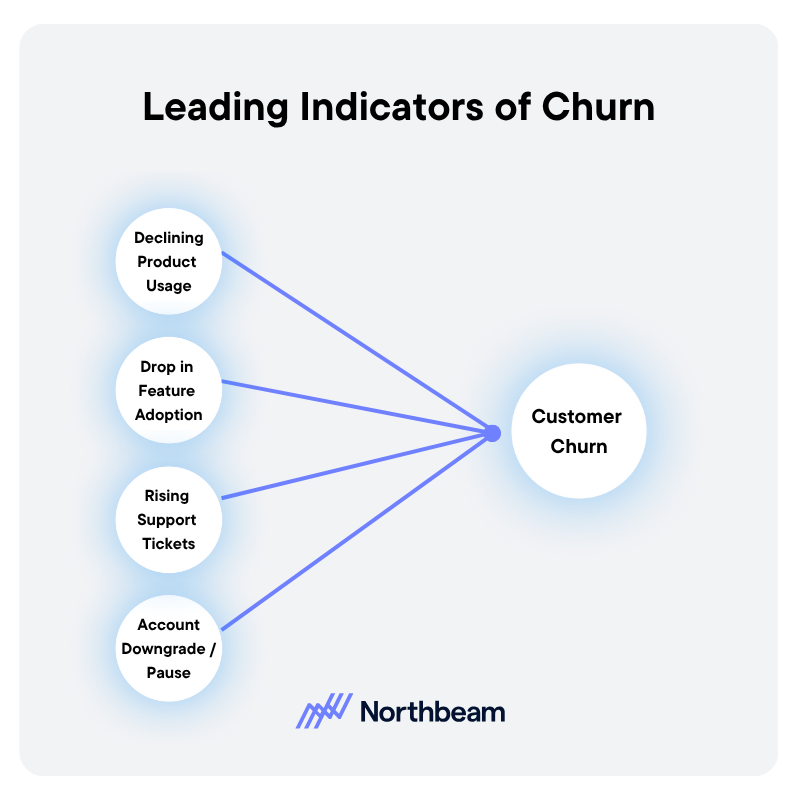
The most valuable churn signals appear before customers actually cancel.
For example, if you’re building churn prevention strategies for SaaS / subscription, watch for:
- Declining product usage or engagement
- Drop in feature adoption or login frequency
- Rising support tickets or unresolved issues
- Account downgrades, paused subscriptions, or missed payments
Tracking these trends helps you intervene while customers are still recoverable.
Customer Health Scores
A composite customer health score combines behavioral, transactional, and sentiment data, such as activity levels, feedback scores, and NPS ratings, to create an at-a-glance view of customer stability.
When a score dips below a certain threshold, it can trigger proactive outreach from your customer success or support teams.
Exit Feedback and Cancellation Data
When a customer leaves, their reason for doing so is invaluable. Use exit surveys or short cancellation forms to capture why they’re leaving, whether its price, missing features, product complexity, or something else.
Over time, this qualitative data helps validate what your metrics can only imply.
Together, these signals create a multidimensional picture of churn, including why customers churn and how to recover them.
Root Causes & Risk Factors of Churn
Churn is rarely random. Beneath every cancellation is a story about unmet expectations, friction, or shifting needs.
Identifying the underlying causes is the difference between reacting to churn and preventing it altogether.
Key causes of churn include:
Poor Product-Market Fit Or Mismatched Expectations
When customers realize the product doesn’t solve their specific problem, or that it promised more than it delivered, churn is inevitable. This often traces back to mismatched messaging during acquisition or an unclear value proposition.
UX Or Performance Issues
Slow load times, buggy releases, or confusing navigation create daily frustration that compounds over time. Even small usability issues can add up, especially when alternatives make switching easy.
Weak Onboarding Or Adoption Support
The first few days or weeks determine whether customers experience value early on. If onboarding is complex, impersonal, or unclear, users may never reach the “aha moment” that makes them stay.
Lack Of Ongoing Engagement Or Value Delivery
Even customers who start strong can drift away if they stop seeing consistent value. When communication drops off, features go unused, or updates fail to excite, engagement naturally declines.
Pricing Misalignment Or Perceived Value Gap
Customers compare what they’re paying to what they’re getting. If competitors offer a similar solution for less, or if the perceived ROI doesn’t justify the cost, price becomes a reason to leave, even if it’s not the real root cause.
Competitive Alternatives Or Product Comparison
A strong product today can still lose customers tomorrow if competitors innovate faster. Churn spikes often follow major market shifts, new features elsewhere, or changing user expectations.
Involuntary Churn
Not all churn is intentional. Payment failures, expired cards, and billing errors can quietly erode retention. These “silent” losses are often easy to fix with better dunning logic, reminder emails, or automated payment recovery.
Seasonal Or External Behavior
Some churn patterns are tied to seasonality or broader market conditions. Retail and travel businesses, for instance, often see predictable dips during off-seasons or economic downturns.
By isolating these drivers, teams can prioritize fixes based on what’s actionable, strengthening product-market fit, improving experiences, and reducing friction points before customers decide to leave.
Churn Recovery & Win-Back Strategies
Even with the best customer retention programs, some churn is inevitable. The key is to treat every lost customer as a potential return, and to design systems that make recovery both scalable and personal.
Effective win-back strategies not only re-engage past customers but also prevent the same issues from recurring.
A strong win-back program includes:
Exit Surveys And Feedback Loops
Every churn event is a chance to learn. Collect exit feedback through short surveys or cancellation flows that ask why customers are leaving.
Segment the responses by reason (pricing, product limitations, service quality, or other themes) to uncover patterns. Aggregating these insights provides a direct map of what to fix first.
Targeted Win-Back Campaigns
Not all customers respond to the same message. Build targeted campaigns that speak directly to the reason for churn: a feature release for users who cited missing functionality, a discount or extended trial for those who found it too expensive, or content highlighting recent improvements.
Personalized “come back” messages show customers that their feedback led to change.
Personalized Outreach And Reactivation Sequences
Beyond automated campaigns, direct contact can make a difference. Combine email, in-app prompts, support calls, and personalized incentives to remind customers of your product’s value.
The most effective reactivation sequences feel human and timely, not generic or pushy.
Flexible Re-Onboarding Paths
When customers return, they shouldn’t have to start from scratch. Offer a smooth, tailored re-onboarding process that acknowledges their prior experience and highlights what’s new or improved since they left.
This reduces friction and helps them quickly rediscover value.
Payment Recovery And Dunning Strategies
For involuntary churn, automation is your ally. Implement retry logic, card update reminders, and grace periods to recover failed payments before accounts lapse.
Well-designed dunning workflows can quietly save a surprising percentage of customers without requiring direct outreach.
Product Improvements And Feature Fixes
Feedback from churned customers is one of the most actionable sources of insight. Use it to prioritize product enhancements, close feature gaps, and eliminate known pain points.
When you resolve the issues that drove people away, win-back campaigns become far more effective.
Segmentation And Differentiated Retention Treatment
Not all customers are equally valuable or equally at risk. Segment your audience by lifetime value, engagement level, or tenure, and apply different levels of intervention.
High-value accounts may warrant one-to-one outreach, while lighter-touch email automations work for lower-value segments.
Predictive Churn Modeling And Early Interventions
The most powerful win-back strategy is prevention.
Use churn prediction models to forecast which customers are likely to leave based on behavioral and transactional data. Then trigger proactive retention campaigns (product nudges, support check-ins, or loyalty rewards) before churn happens.
Together, these tactics turn churn into a continuous learning loop: diagnose, improve, re-engage, and retain.
Tools & Methods for Churn Analysis
Successful churn analysis relies on the right combination of tools, data, and analytical approaches.
It’s not just about tracking who left, it’s about connecting signals across platforms to reveal why they left and what to do next.
Analytics Platforms
Tools like Amplitude, Pendo, and Tableau help teams visualize behavioral data, track engagement trends, and monitor how customer actions correlate with retention.
These platforms are essential for identifying the early warning signs of churn, such as reduced feature usage or declining session frequency.
Subscription Analytics Tools And Dashboards
For subscription-based or SaaS businesses, tools like Baremetrics and ChartMogul provide specialized dashboards for metrics like monthly recurring revenue (MRR), churn rate, and lifetime value (LTV).
These insights allow you to quantify churn’s financial impact and track improvements over time.
Machine Learning And Statistical Modeling
Predictive churn models use techniques such as logistic regression, random forest, and ensemble learning to forecast which customers are most likely to churn.
By training on historical data, these models identify patterns that human analysts might miss, enabling proactive interventions before cancellations occur.
Feature Engineering
Behind every predictive model lies smart feature engineering, deriving metrics like usage frequency, time since last activity, or support interaction counts.
These variables translate raw data into meaningful indicators of customer health and churn risk.
Cohort And Retention Analysis
Cohort tables and survival analysis reveal how long different customer segments remain active.
Tracking retention curves helps teams see where drop-offs occur and whether recent initiatives (like onboarding improvements or pricing updates) are having a measurable impact.
Cancellation Surveys And Qualitative Feedback
While quantitative data shows what is happening, qualitative insights explain why.
Exit surveys, user interviews, and customer feedback channels reveal the human reasons behind churn, turning raw metrics into actionable strategy.
A/B Testing Of Retention And Win-Back Techniques
Run controlled experiments to measure which retention tactics work best, whether it’s a new reactivation email, a feature release notification, or an incentive offer.
Continuous testing helps refine your churn prevention and win-back playbooks.
Regular Audits And Dashboards With Alerting
Establish ongoing churn monitoring with real-time dashboards and automated alerts.
By flagging sudden spikes or unusual churn patterns early, teams can investigate root causes and act before small issues scale into major losses.
Together, these tools and methods turn churn analysis into a living system that continuously learns, predicts, and optimizes retention outcomes over time.
Churn Analysis Example: eCommerce Case Study
To see churn analysis in practice, consider a hypothetical e-commerce brand called Glow that sells subscription-based beauty boxes.
Despite steady new signups, Glow noticed revenue plateauing and suspected a churn problem.
Using churn analysis, the team uncovered a clear pattern: while overall churn averaged 12% per month, a deeper segmentation analysis revealed one hidden, high-churn cohort: first-time subscribers acquired through social media ads.
This group was churning at nearly 30%, twice the company average.
When Glow dug deeper into behavioral data, several red flags emerged for this cohort:
- Lower engagement with post-purchase emails and community content
- High rates of unopened boxes and skipped shipments
- Frequent “product didn’t match expectations” feedback in exit surveys
Armed with these insights, the team took a multi-pronged approach:
- Targeted win-back campaigns: They launched personalized “We Miss You” emails featuring a sneak peek of next month’s box and a 15% discount for returning customers.
- Flexible re-onboarding: Returning users were invited to retake the beauty quiz to refresh their preferences, ensuring the next box felt customized and new.
- Product improvements: The company expanded its quiz logic and supplier pool to better match items with customer profiles.
- Predictive modeling: Using usage and engagement data, Glow built a churn prediction model that flagged high-risk subscribers after their first shipment, triggering proactive check-ins.
Within three months, Glow saw measurable results:
- Churn dropped by 29% in the target segment
- Revenue per subscriber increased due to longer retention
- Exit survey mentions of “poor fit” decreased by 40%
By pairing segmentation analysis with tailored recovery strategies, Glow transformed churn from a hidden leak into a source of actionable insight and built a system that keeps customers engaged long after their first purchase.
Churn Analysis Best Practices Checklist
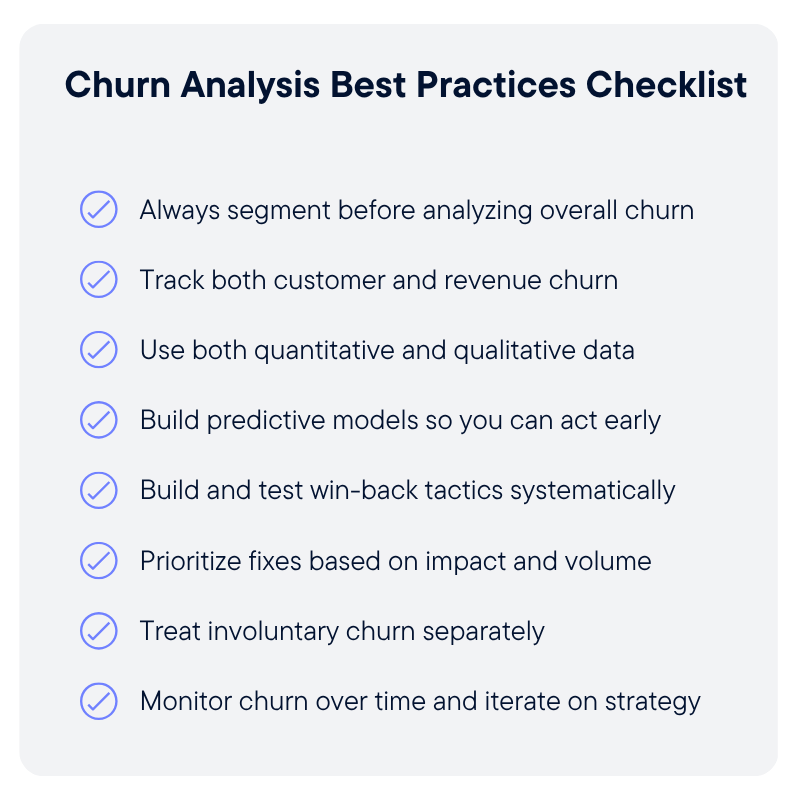
These eight best practices ensure your churn analysis insights stay sharp and your retention strategies keep evolving.
1. Always Segment Before Analyzing Overall Churn
Aggregate churn rates can hide important differences between customer groups. Break data down by plan type, acquisition source, region, or tenure to reveal where attrition truly happens.
2. Track Both Customer And Revenue Churn
Losing one enterprise client can outweigh dozens of small accounts. Measuring both customer count and revenue impact helps you focus on the churn that matters most.
3. Use A Combination Of Quantitative And Qualitative Data
Metrics show what’s happening, but feedback explains why. Pair product analytics with surveys, interviews, and support transcripts to see the full picture.
4. Build Predictive Models To Act Early
Don’t wait for churn to happen. Use machine learning or behavioral scoring to flag customers showing early signs of disengagement and trigger targeted retention actions.
5. Test Win-Back Tactics Systematically
Treat reactivation like an experiment. A/B test subject lines, offers, and messaging to discover which tactics yield the highest recovery rates.
6. Prioritize Fixes Based On Impact And Volume
Not every churn driver deserves equal attention. Rank causes by how many customers they affect and how easily they can be resolved, focusing first on high-volume, high-impact issues.
7. Treat Involuntary Churn Separately
Payment failures and account issues are operational, not emotional. Use automated billing retries and clear communication to recover these customers efficiently.
8. Monitor Churn Over Time And Iterate
Retention strategies aren’t one-and-done. Track trends quarterly, measure progress against baselines, and refine your approach as products, markets, and customer expectations evolve.
When followed consistently, these principles turn churn analysis from a reactive report into a continuous engine for retention and growth.
Turn Churn Into Opportunity
Churn is an unavoidable part of doing business, but how you respond to it determines whether it stays a revenue leak or becomes a growth lever.
With the right data, tools, and processes, churn analysis transforms from a backward-looking metric into a forward-looking advantage.
Every lost customer offers insight into how to build a better product, experience, and relationship. By identifying early warning signals, understanding root causes, and applying targeted win-back strategies, teams can not only reduce churn but also strengthen customer loyalty and lifetime value.
Next steps:
- Audit your churn metrics: Track both customer and revenue churn?
- Build an exit feedback loop: Capture reasons for departure and aggregate them by cause.
- Pilot one win-back campaign: Target a single churn segment and measure your recovery rate.
With thoughtful analysis and proactive retention, every departure becomes a chance to learn, adapt, and grow stronger.

Follow us














.svg)
